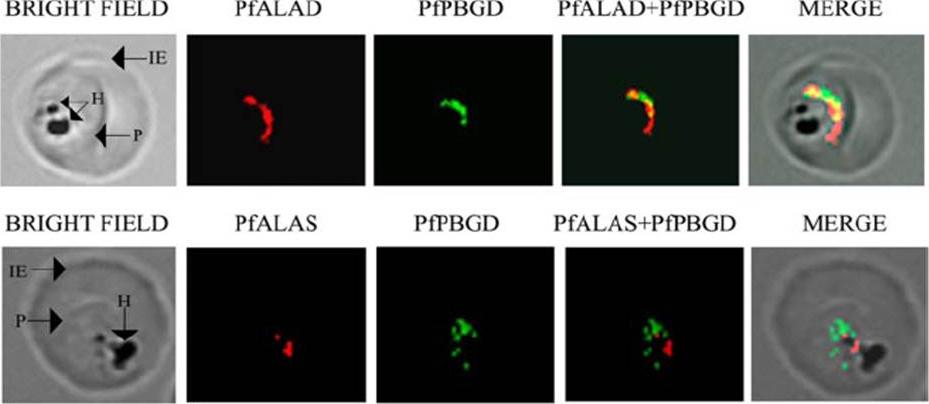PBANKA_1459200 delta-aminolevulinic acid synthetase (ALAS)
Disruptability [+]
| Species | Disruptability | Reference | Submitter | |
|---|---|---|---|---|
| P. berghei ANKA |
Possible |
RMgm-1582 | Imported from RMgmDB | |
| P. berghei ANKA |
Possible |
RMgm-1576 | Imported from RMgmDB | |
| P. berghei ANKA |
Possible |
RMgm-924 | Imported from RMgmDB | |
| P. berghei ANKA |
Possible |
PlasmoGEM (Barseq) | PlasmoGEM | |
| P. berghei ANKA |
Possible |
RMgm-5262 | Imported from RMgmDB | |
| P. falciparum 3D7 |
Possible |
25352601 | Theo Sanderson, Wellcome Trust Sanger Institute | |
| P. falciparum 3D7 |
Refractory |
USF piggyBac screen (Insert. mut.) | USF PiggyBac Screen | |
Mutant phenotypes [+]
| Species | Stage | Phenotype | Reference | Submitter |
|---|---|---|---|---|
| P. berghei ANKA | Asexual |
No difference |
RMgm-1582 | Imported from RMgmDB |
| P. berghei ANKA | Asexual |
No difference |
RMgm-924 | Imported from RMgmDB |
| P. berghei ANKA | Asexual |
No difference |
PlasmoGEM (Barseq) | PlasmoGEM |
| P. berghei ANKA | Asexual |
Difference from wild-type |
RMgm-5262
ECM-susceptible C57BL/6 were by injected with 10(5) asexual stage parasites. Blood parasitemia showed 23 days delay in the growth of ALAS-KO parasites with respect to the wild type (WT). About 80% of the WT-infected mice succumbed to ECM within day 10 when the blood parasitemia was around 1030%. In contrast, mice infected with ALASKO and FCKO parasites were protected from ECM and they died because of anemia on day 2030. |
Imported from RMgmDB |
| P. berghei ANKA | Gametocyte |
No difference |
RMgm-924 | Imported from RMgmDB |
| P. berghei ANKA | Ookinete |
No difference |
RMgm-1582 | Imported from RMgmDB |
| P. berghei ANKA | Ookinete |
No difference |
RMgm-924 | Imported from RMgmDB |
| P. berghei ANKA | Oocyst |
Difference from wild-type |
RMgm-1582
Normal numbers of oocysts are formed. However, day 10 and 14 oocysts had a reduced size (`60%) compared to wild type oocysts. A large (~10-20-fold) reduction in the numbers of midgut-associated sporozoites was observed. No hemocoel or salivary gland sporozoites were detected. |
Imported from RMgmDB |
| P. berghei ANKA | Oocyst |
Difference from wild-type |
RMgm-924
Strongly reduced oocyst production |
Imported from RMgmDB |
| P. berghei ANKA | Sporozoite |
Difference from wild-type |
RMgm-1582
Normal numbers of oocysts are formed. However, day 10 and 14 oocysts had a reduced size (`60%) compared to wild type oocysts. A large (~10-20-fold) reduction in the numbers of midgut-associated sporozoites was observed. No hemocoel or salivary gland sporozoites were detected. |
Imported from RMgmDB |
| P. berghei ANKA | Sporozoite |
Difference from wild-type |
RMgm-924
Strongly reduced oocyst and sporozoite production.Mice remained negative when infected by mosquito bite or after i.v. injection of sporozoites (see also additional remarks phenotype) |
Imported from RMgmDB |
| P. berghei ANKA | Liver |
Difference from wild-type |
RMgm-1582
A large (~10-20-fold) reduction in the numbers of midgut-associated sporozoites was observed. No hemocoel or salivary gland sporozoites were detected. No mosquito transmission. See also additional information of the role of ALAS during liver stage development |
Imported from RMgmDB |
| P. berghei ANKA | Liver |
Difference from wild-type |
RMgm-924
Mice remained negative when infected by mosquito bite or after i.v. injection of mutant sporozoites (see also additional remarks phenotype) |
Imported from RMgmDB |
| P. falciparum 3D7 | Asexual |
No difference |
25352601 | Theo Sanderson, Wellcome Trust Sanger Institute |
Imaging data (from Malaria Metabolic Pathways)

Localization of PfCPO by immunofluorescence microscopy. Localization of PfCPO with Mitotracker green (mitochondrial marker), PfALAS (mitochondrial marker) and PfUROD (apicoplast marker) was studied. IE, infected erythrocyte; P, parasite; H, hemozoin. Scale bar=5 μm. results presented in Fig. 4 indicate that the PfCPO signal was distributed throughout the parasite, but did not colocalize with that of Mitotracker dye (mitochondrial marker), PfALAS (mitochondrial marker) or PfUROD (apicoplast marker).Nagaraj VA, Prasad D, Arumugam R, Rangarajan PN, Padmanaban G. Characterization of coproporphyrinogen III oxidase in Plasmodium falciparum cytosol. Parasitol Int. 2010 59:121-127. Copyright Elsevier 2011
See original on MMP
Localization of porphobilinogen deaminase PfPBGD with d-aminolevulinate dehydratase PfALAD and d-aminolevulinic acid synthase PfALAS in P. falciparum by immunofluorescence. PGDB and PfALAD are localized to the apicoplast. PfALAS is localized to the mitochondrion. IE, infected erythrocyte; P, parasite; H, hemozoin.Sato S, Clough B, Coates L, Wilson RJ. Enzymes for heme biosynthesis are found in both the mitochondrion and plastid of the malaria parasite Plasmodium falciparum. Protist. 2004 155:117-25. Copyright Elsevier 2009.
See original on MMP
Co-localization of ALAS with MitoTracker dye and Hsp60 in P. falciparum. Top row : (a) bright ®eld (the contour of the infected cell is indicated since it is not clearly visible) ; (b) Hoechst stain ; (c) MitoTracker fluorescence in parasite ; (d) ALAS immuno¯uorescence with PfALAS antibody and FITC-conjugated secondary antibody ; (e) co-localization of (c) and (d). Bottom row : (a) bright field ; (b) Hoescht stain ; (c) Hsp60 immunofuorescence with Hsp60 antibody in rabbits and tetramethylrhodamine b-isothiocyanate (TRITC)-conjugated anti-rabbit antibody in goat ; (d) ALAS immuno-fluorescence with ALAS antibody in mice and FITC-conjugated anti-mouse antibody in goat ; (e) c-localization of (c) and (d).Varadharajan S, Dhanasekaran S, Bonday ZQ, Rangarajan PN, Padmanaban G. Involvement of delta-aminolaevulinate synthase encoded by the parasite gene in de novo haem synthesis by Plasmodium falciparum. Biochem J. 2002 Oct 15;367(Pt 2):321-7. PubMed
See original on MMPMore information
| PlasmoDB | PBANKA_1459200 |
| GeneDB | PBANKA_1459200 |
| Malaria Metabolic Pathways | Localisation images Pathways mapped to |
| Previous ID(s) | PB000228.01.0, PBANKA_145920 |
| Orthologs | PCHAS_1461500 , PF3D7_1246100 , PKNH_1465700 , PVP01_1463100 , PVX_101195 , PY17X_1461800 |
| Google Scholar | Search for all mentions of this gene |